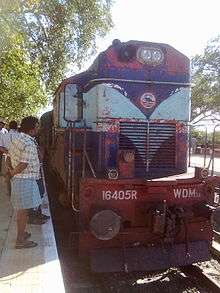Boat Mail

The Boat Mail was a combined train and steamer ferry service between India and Ceylon (now Sri Lanka). Connecting Chennai and Colombo, the system initially utilised a rail-to-sea operation, but changed to a rail-to-sea-to-rail operation.[1] Passengers could buy a single ticket for the journey.[2]
History
Tuticorin-Colombo era
In the late 19th century, the railway portion of the route within India was from Madras (Chennai) to Tuticorin. At Tuticorin, passengers embarked on the boat mail steamer to Colombo in Ceylon. The train took 21 hours and 50 minutes for the journey from Madras to Tuticorin. The Boat Mail was one of the early trains to be given vestibuled carriages, in 1898.[1]
Dhanushkodi-Talaimannar era
In 1914, after the Pamban bridge was built, the train's route changed and it went from Madras to Dhanushkodi.[3] A much shorter ferry service then took the passengers to Talaimannar in Ceylon, from where another train went to Colombo. The 35-kilometre (22 mi) long ferry journey was considerably shorter than the 270-kilometre (170 mi) long Tuticorin-Colombo route.
Post cyclone
In 1964 a passenger train was washed into the sea by huge waves during the 1964 cyclone, when nearing Dhanushkodi. The railway tracks and the pier at Dhanushkodi were also destroyed. Following this, the Indian portion of the train service now only operates up to Rameswaram,[2] while the ferry service to Talaimannar has since been discontinued.
Alternative Proposals
At one time the South Indian Railway considered constructing a bridge 12 miles (19 km) long across the shallow waters and sand shoals and reefs known as Rama Sethu (Adam's Bridge) between India and Sri Lanka. However, this plan was shelved when World War I broke out.
See also
- Boatmail Express
- Flemingo Liners, the post-war successor to the Boat Mail.
- List of named passenger trains of Sri Lanka
- Rail transport in India
References
- 1 2 http://www.irfca.org/faq/faq-seltrain.html Famous Trains
- 1 2 Saqaf, Syed Muthahar (14 June 2010). "'Boat Mail' to run on main line from August 1". The Hindu. Retrieved 14 February 2012.
- ↑ "Imperial Indian Mail". trains-worldexpresses.com. Retrieved 14 February 2012.
